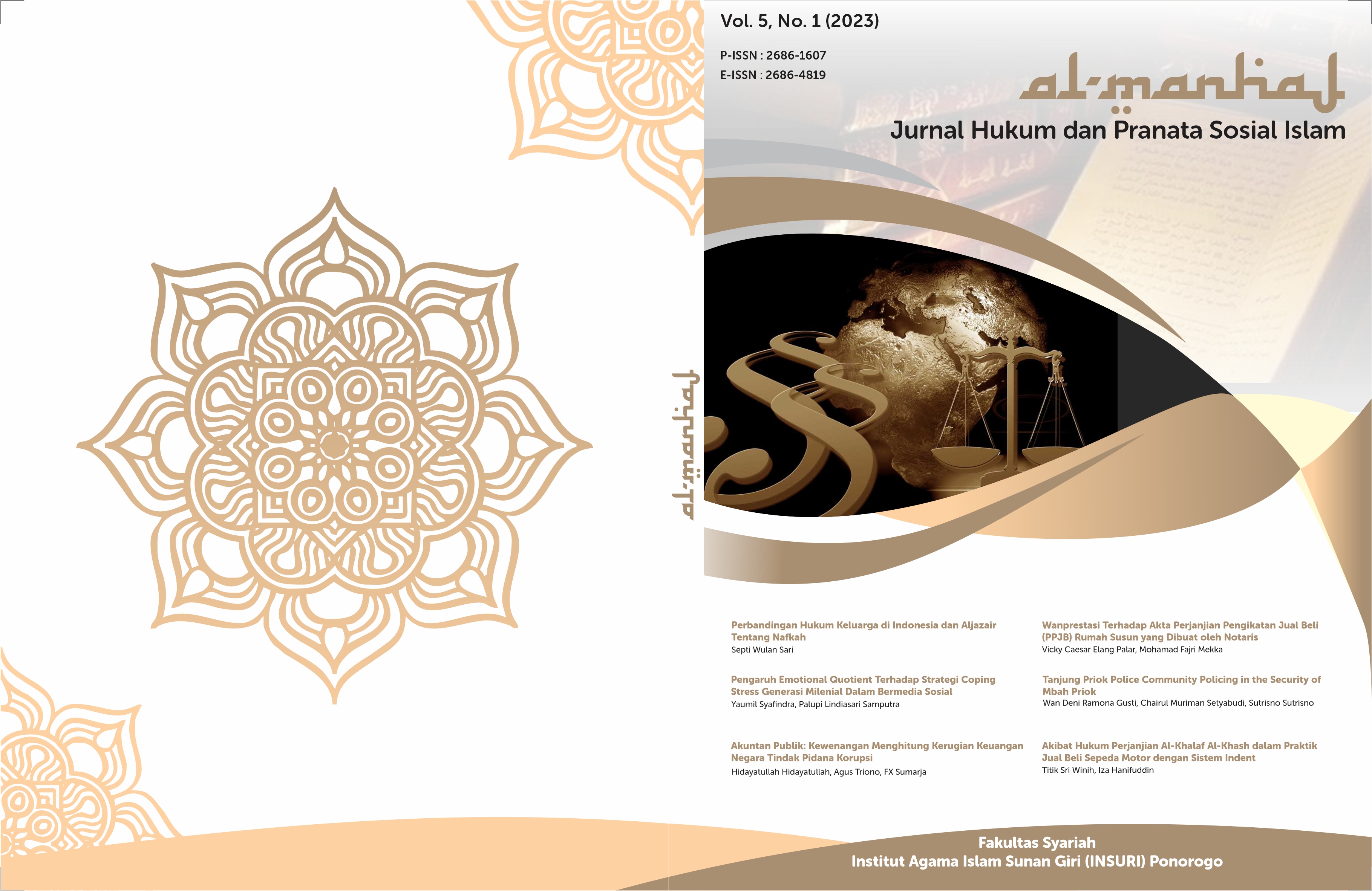Kewenangan Mengadili Dalam Penyelesaian Perkara Kepailitan dan Penundaan Kewajiban Pembayaran Utang Perbankan Syariah
DOI:
https://doi.org/10.37680/almanhaj.v5i1.2195Keywords:
Authority to adjudicate; Bankruptcy and PKPU; Syariah bankingAbstract
The Religious Courts are the only legal institution authorized to resolve sharia economic disputes, based on Law Number 3 of 2006 concerning Religious Courts. This is also supported by Supreme Court Regulation Number 14 of 2016 concerning Procedures for Settlement of Sharia Economic Cases. However, there are still many sharia business/shariah banking cases in commercial courts where legal submissions are tug-of-war in a dichotomy between the absolute competence of the Religious Courts and submission to the authority of the commercial court within the district court environment. So that there is regulatory disharmony and legal uncertainty regarding jurisdictional decisions in bankruptcy cases of Islamic economic institutions. This research method uses normative research by examining legal materials related to bankruptcy and PKPU. The results of the study indicate that it is necessary to unify and harmonize regulations that specifically regulate the settlement of sharia bankruptcy cases so that there are no jurisdictional conflicts between the Religious Courts and the Commercial Courts. Legal consequences if the bankruptcy case of Islamic banking is still filed at the Commercial Court, there will be coercion of the substance of sharia economic law to become conventional economic law, so that the settlement of the dispute is not in sync with the contract and the concept of settlement of cases which prioritizes business concepts and business continuity rather than fairness and certainty. substantive.
References
DPR RI. (2006). Undang-Undang Nomor 03 Tahun 2006 tentang Peradilan Agama. Retrieved from Ekonomi Syariah, Wapres: Masih Ada Disharmanoni Aturan Hukum - Ekonomi Bisnis.com, diakses pada tanggal 02 Juni 2022.
DPR RI. (2008). Undang-Undang Nomor 21 Tahun 2008 tentang Perbankan Syari’ah.
Kanza, A. (2017). Penyelesaian Sengkete Kepailitan Pada Lembaga Keuangan Syariah (Analisis Putusan Nomor: 12/ Pdt.Sus-Pailit/ 2017/ PN Niaga SMG. Penyelesaian Sengkete Kepailitan Pada Lembaga Keuangan Syariah (Analisis Putusan Nomor: 12/ Pdt.Sus-Pailit/ 2017/ PN Niaga SMG.
Lubis, D. A. (2013). Kepailitan Menurut Ibn Rusyd dan Pebandingannya Dengan Hukum Kepailitan di Indonesia. Jurnal Hukum Islam, XIII(2).
Mahkamah Konstitusi. (2004). Undang-Undang Nomor 37 Tahun 2004 tentang Kepailtan dan Penundaan Kewajiban Pembayaran Utang (PKPU).
Mardatillah, A. (2021). Mendorong Penyelesaian Perkara Kepailitan Syariah Masuk Wewenang Pengadilan Agama. Artikel Hukum Online.Com. Retrieved from https://www.hukumonline.com/klinik/a/kepailitan-akibat-akad-murabahah--di-pengadilan-agama-atau-pengadilan-niaga-lt534b3a24f317c diakses pada tanggal 08 Juni 2022
Muhammad, A. (2004). Hukum dan Penelitian Hukum. Bandung: Citra Aditya Bakdi.
Natasha, S. (2022). Pengurusan Penjualan Saham Sebagai Objek Harta Kekayaan dalam Boedel Afwezigheid. Jurnal Manhaj, 4(2).
Novanilia, A. (2021). Quo Vadis Penyelesaian Perkara Kepailitan dan Penundaan Kewajiban Pembayaran Utang (Pkpu) Pada Lembaga Keuangan Syariah. Journal Of Law And Policy Transformation, 6(2). Retrieved from https://www.hukumonline.com/klinik/a/kepailitan-akibat-akad-murabahah--di-pengadilan-agama-atau-pengadilan-niaga-lt534b3a24f317c, diakses pada tanggal 08 Juni 2022
Safrudin, A., & Satiri, A. (2018). Teknik Penyelesaian Perkara Kepailitan Ekonomi Syariah. Yogyakarta: Pustaka Pelajar.
Suadi, A. (2017). Penyelesaian Sengketa ekonomi Syariah Teori dan Ekonomi. Jakarta: Kencana.
Tim. (2013). Babak Baru Penyelesaian Sengketa Ekonomi Syariah (Edisi 3). Majalah Peradilan Agama.
Downloads
Published
How to Cite
Issue
Section
License
Copyright:
- Author retains the copyright and grants the journal the right of first publication of the work simultaneously licensed under a Creative Commons Attribution 4.0 International License that allows others to share the work with an acknowledgment of the work's authorship and initial publication in this journal.
- Author is able to enter into separate, additional contractual arrangements for the non-exclusive distribution of the journal's published version of the work (e.g., post it to an institutional repository or publish it in a book) with the acknowledgment of its initial publication in this journal.
- Author is permitted and encouraged to post his/her work online (e.g., in institutional repositories or on their website) prior to and during the submission process, as it can lead to productive exchanges, as well as earlier and greater citation of the published work (See The Effect of Open Access).
License:
-
Attribution — You must give appropriate credit, provide a link to the license, and indicate if changes were made. You may do so in any reasonable manner, but not in any way that suggests the licensor endorses you or your use.
-
No additional restrictions — You may not apply legal terms or technological measures that legally restrict others from doing anything the license permits.
You are free to:
- Share — copy and redistribute the material in any medium or format
- Adapt — remix, transform, and build upon the material for any purpose, even commercially.

This work is licensed under a Creative Commons Attribution 4.0 International License.














